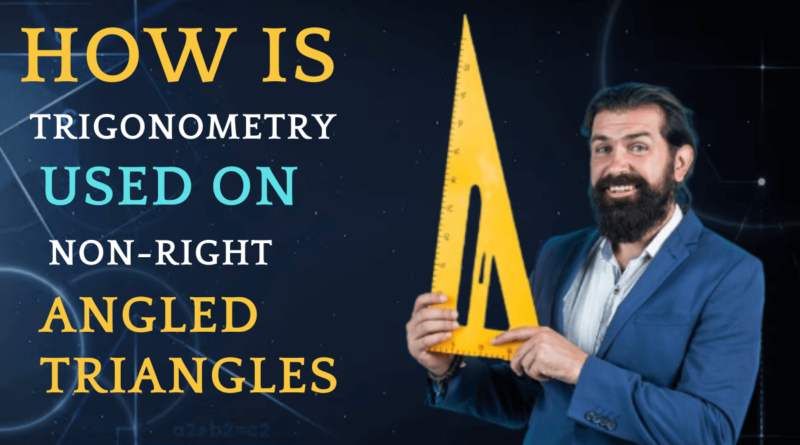How Is Trigonometry Used On Non-Right Angled Triangles?
Trigonometry, the study of relationships between the angles and sides of triangles, is a branch of mathematics that extends far beyond the familiar right-angled triangle scenarios. While many associate trigonometry with right triangles, its applications extend to non-right-angled triangles, providing a powerful toolset for solving complex problems in various fields. In this comprehensive exploration, we delve into how trigonometry is not confined to right-angled triangles and discover its versatile applications.
Understanding Trigonometry Beyond Right-Angled Triangles
Trigonometric Ratios
In traditional trigonometry, sine, cosine, and tangent functions are defined solely for right-angled triangles. However, by introducing the unit circle concept, these ratios can be extended to non-right angled triangles. This opens the door to a broader range of applications and problem-solving techniques.
What is a Trig Circle Chart?
A Trig Circle Chart, or a unit circle chart, is a visual representation of trigonometric functions around the unit circle. It includes sine, cosine, and tangent values for various angles, providing a quick reference for solving problems.
Trig Circle Chart Values: Unraveling the Unit Circle
The unit circle, a circle with a radius of 1, plays a crucial role in extending trigonometric functions beyond right angles. The Trig Circle Chart values offer insights into the relationships between angles and the coordinates of points on the unit circle.
Utilizing the Trig Circle Chart in Problem Solving
It often involves finding angles or sides using trigonometric ratios. The Trig Circle Chart becomes an invaluable tool, allowing us to easily identify sine, cosine, and tangent values for any angle, facilitating efficient problem-solving.
Unit Circle Diagram
Navigating the Unit Circle Diagram
The unit circle diagram visually represents angles and their corresponding coordinates on the unit circle. This aids in understanding trigonometric functions, offering a geometric perspective to supplement mathematical calculations.
Connecting Angles and Coordinates
By associating angles with coordinates on the unit circle, the unit circle diagram bridges the gap between geometry and trigonometry. This connection proves essential when dealing with them, where visualizing the relationships between angles and sides is paramount.
Applications
Navigation and Surveying
In navigation and surveying, trigonometry plays a pivotal role in determining distances, heights, and angles between non-right angled points. Ship captains, pilots, and surveyors rely on trigonometric principles to navigate vast terrains with precision.
Engineering and Architecture
Engineers and architects encounter triangles regularly in designing structures and analyzing forces. Trigonometry aids in calculating the angles of inclination, load distribution, and other critical parameters, ensuring the structural integrity of buildings and bridges.
Physics and Mechanics
In the realm of physics and mechanics, trigonometry is indispensable for analyzing forces, motion, and trajectories. Non-right angled triangles arise when dealing with inclined planes, projectile motion, and various dynamic systems.
Astronomy
Astronomers harness trigonometry to measure distances between celestial objects, determine elevation angles, and analyze celestial events. The study of triangles becomes fundamental in celestial navigation and calculating astronomical distances.
Computer Graphics and Animation
In computer graphics and animation, trigonometry is used to model and manipulate three-dimensional objects. Understanding triangles is essential for creating realistic visual effects and animations.
Medical Imaging
Medical imaging techniques, such as computed tomography (CT) scans and magnetic resonance imaging (MRI), rely on trigonometry to reconstruct detailed human body images. Triangles emerge in the intricate calculations involved in these imaging processes.
FAQs
How is trigonometry used on non-right angled triangles?
Trigonometry on non-right angled triangles involves extending traditional trigonometric ratios to include sine, cosine, and tangent functions using the unit circle. This allows for the calculation of angles, sides, and other parameters in triangles that do not have a right angle.
What is a Trig Circle Chart, and how does it relate to non-right angled triangles?
A Trig Circle Chart, also known as a unit circle chart, provides a visual reference for trigonometric values on the unit circle. It is a crucial tool in solving problems by offering quick access to sine, cosine, and tangent values for various angles.
How does the unit circle diagram assist in understanding trigonometry?
The unit circle diagram visually represents angles and their corresponding coordinates on the unit circle. It helps bridge the gap between geometry and trigonometry, offering a geometric perspective that aids in understanding and solving related problems.
What are some practical applications of trigonometry on non-right angled triangles?
Trigonometry finds applications in navigation, surveying, engineering, architecture, physics, mechanics, astronomy, computer graphics, animation, and medical imaging. It is a versatile tool that contributes to solving real-world problems in various fields.
Can trigonometry be applied in computer graphics and animation?
Yes, trigonometry is extensively used in computer graphics and animation. It helps model and manipulate three-dimensional objects, and understanding trigonometry is crucial for creating realistic visual effects and animations.
How does trigonometry contribute to medical imaging techniques?
Trigonometry plays a vital role in medical imaging techniques such as computed tomography (CT) scans and magnetic resonance imaging (MRI). It is used to perform complex calculations involved in reconstructing detailed images of the human body, where it often comes into play.
Conclusion
The applications of trigonometry extend well beyond right-angled triangles, proving to be a versatile and indispensable tool in various fields. The integration of the unit circle, Trig Circle Chart, and unit circle diagram allows for the effective utilization of trigonometric functions on non-right angled triangles. As we continue to explore and apply these principles, the boundaries of mathematical problem-solving expand, revealing the depth and breadth of trigonometry’s impact on the world around us.
